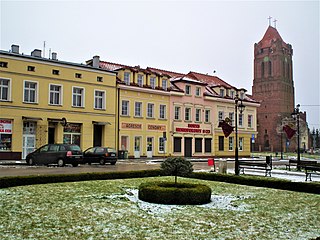
Prabuty is a town in Kwidzyn County within the Pomeranian Voivodeship of northern Poland. It is the seat of Gmina Prabuty.

The Marienwerder Region was a government region (Regierungsbezirk) of Prussia from 1815 until 1920 and again 1939-1945. It was a part of the Province of West Prussia from 1815 to 1829, and again 1878–1920, belonging to the Province of Prussia in the intervening years, and to the Reichsgau Danzig-West Prussia in the years 1939-1945. The regional capital was Marienwerder in West Prussia.

Nowe Miasto Lubawskie is a town in northern Poland, situated on the River Drwęca. The total population in June 2018 was 11,062. Nowe Miasto Lubawskie is the capital of Nowe Miasto County in the Warmian-Masurian Voivodeship.

The Province of West Prussia was a province of Prussia from 1773 to 1829 and 1878 to 1919. West Prussia was established as a province of the Kingdom of Prussia in 1773, formed from Royal Prussia of the Polish–Lithuanian Commonwealth annexed in the First Partition of Poland. West Prussia was dissolved in 1829 and merged with East Prussia to form the Province of Prussia, but was re-established in 1878 when the merger was reversed and became part of the German Empire. From 1918, West Prussia was a province of the Free State of Prussia within Weimar Germany, losing most of its territory to the Second Polish Republic and the Free City of Danzig in the Treaty of Versailles. West Prussia was dissolved in 1920, and its remaining western territory was merged with Posen to form Posen-West Prussia, and its eastern territory merged with East Prussia as the Region of West Prussia district.

Dzierzgoń is a town in the Pomeranian Voivodeship in northern Poland. It is located in Sztum County east of Malbork and south of Elbląg on the river Dzierzgoń. Dzierzgoń has a population of 5,242, while the town and its environs have a combined population of about 10,000.
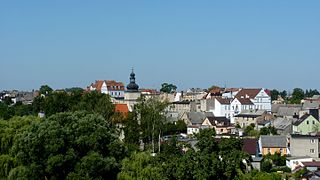
Sępólno Krajeńskiepronounced[sɛmˈpulnɔkraˈjɛɲskʲɛ] is a town in northern Poland, in the Kuyavian-Pomeranian Voivodeship. It is the capital of Sępólno County and Gmina Sępólno Krajeńskie.
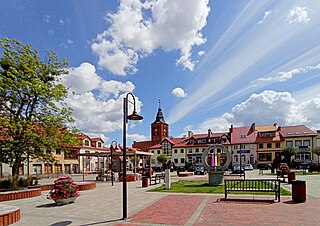
Susz is a town in Iława County, Warmian-Masurian Voivodeship, in northern Poland, with 5,610 inhabitants (2006).
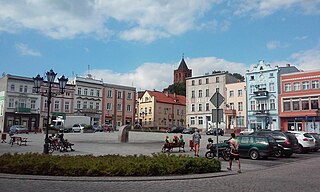
Nowe is a town in Świecie County, Kuyavian-Pomeranian Voivodeship, Poland, with 6,270 inhabitants (2004). It is located within the ethnocultural region of Kociewie.

Gardeja is a village in Kwidzyn County, Pomeranian Voivodeship, in northern Poland. It is the seat of the gmina called Gmina Gardeja. It had been a town during the time span 1334–1945.
Landkreis Marienwerder was a Kreis, or district, of Prussia from 1752 to 1945. Its capital was Marienwerder (Kwidzyn).
The West Prussia Region was a government region (Regierungsbezirk) of Prussia from 1920 until 1939. The regional capital was Marienwerder in West Prussia. It was the eastern part of Marienwerder Region which voted to be incorporated within the Weimar Republic and joined the Province of East Prussia from 1922 to 1939. It was replaced again by the reconstituted Marienwerder Region in 1939 until its dissolution in 1945.

The Danzig Region was a government region, within the Prussian Provinces of West Prussia and Prussia. The regional capital was Danzig (Gdańsk). Prussian government regions were not bodies of regional self-rule of the districts and cities comprised, but shear top-to-down government agencies to apply federal or state law and supervise local entities of self-rules, such as municipalities, rural and urban districts.

The Gauliga Danzig-Westpreußen was the highest football league in the former Reichsgau Danzig-West Prussia, a Nazi administrative unit established partly from German and partly from annexed territory.
Nowa Tuchola is a settlement, part of the village of Mały Mędromierz in the administrative district of Gmina Tuchola, within Tuchola County, Kuyavian-Pomeranian Voivodeship, in north-central Poland.

Kreis Dirschau was a Prussian district which existed with varying borders from 1772 to 1818 and from 1887 to 1920. In 1920, following World War I the district was ceded by the German Empire partly to Poland and partly to the Free City of Danzig in accordance Treaty of Versailles. From 1939 to 1945 the district in occupied Poland was re-established as part of the wartime Reichsgau Danzig-West Prussia. Today the former district is in the Polish Pomeranian Voivodeship.
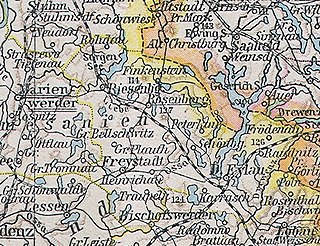
The district of Rosenberg in Westpreußen was a Prussian district that existed from 1818 to 1945. The territory of the district is now located within the Polish Warmian-Masurian Voivodeship.
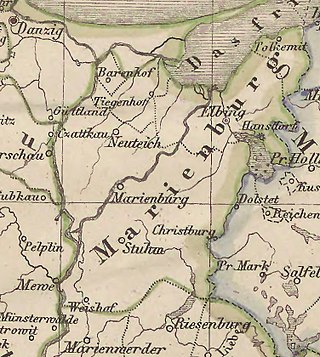
The Marienburg district was a Prussian district that existed from 1772 to 1945. The district originally belonged to the province of West Prussia and was divided in 1920 by the Treaty of Versailles. Its western half fell to the Free City of Danzig, while its eastern half became part of the province of East Prussia and remained in the German Reich until 1945. The district capital was Marienburg. The territory of the district is now part of the Pomeranian Voivodeship in Poland.
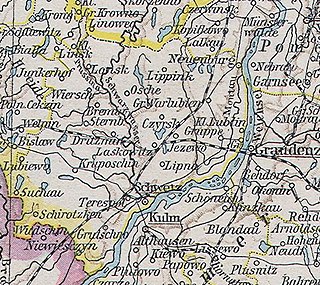
Kreis Schwetz was a Prussian district that existed from 1818 to 1920, with its capital at Schwetz. The district was located on the western bank of the Vistula river in the part of West Prussia that fell to Poland after the First World War through the Treaty of Versailles in 1920.
Kreis Labiau was a district in East Prussia that existed from 1818 to 1945. It was located on the southeastern coast of the Curonian Lagoon and had the town of Labiau as its capital.

The district of Thorn was a Prussian district in the Marienwerder administrative region that existed from 1818 to 1920. It belonged to the province of West Prussia, except for the period from 1829 to 1878 when it was part of the Province of Prussia. Its capital was Thorn. It was in the part of West Prussia that fell to Poland after World War I in 1920 through the Treaty of Versailles. From 1939 to 1945, the district of Thorn was re-established in Reichsgau Danzig-West Prussia in occupied Poland. Today, the area of the district is in the Kuyavian-Pomeranian Voivodeship in Poland.
















